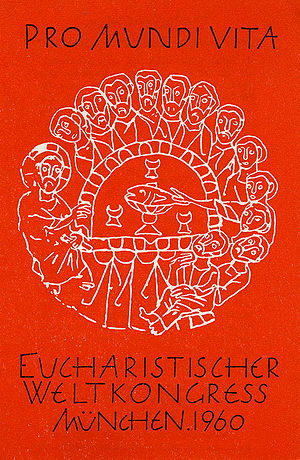
Michael Fellner (†)
The International Eucharistic Congress of 1960 was held in Munich. It was the first major event of international significance in post-war Germany. Numerous larger and smaller church services were accompanied by a colourful supporting programme, which was broadcast on radio and television. New liturgical trends, which were to become an integral part of the liturgy in the wake of the Second Vatican Council, were addressed in Munich and discussions between Catholics and other faith communities took place.
The tradition of International Eucharistic Congresses
The event form of the Eucharistic Congress has French roots. It was intended to ensure the effectiveness of the Catholic claim to faith and was a response to two tendencies: Jansenism, a direction within French Catholicism condemned by Rome for its deviant doctrine of grace, and increasing atheistic tendencies in 19th century France. The first congress, which already brought together participants from eight countries, was held in Lille (France) in 1883. At the centre of the following congresses was always the solemn procession through the hosting city, accompanied by supporting events on a predetermined theme. Almost all congresses were held in France itself or in francophone countries at intervals of one or two years until the first decade of the 20th century. This was followed by an expansion into the pan-European area, and from the 1920s onwards also overseas (Chicago 1926, Sydney 1928, Buenos Aires 1934). The first International Eucharistic Congress in Germany was held in Cologne in 1909.
The preparation phase for the International Congress in Munich
The Munich Cardinal Joseph Wendel (1901-1960, Archbishop 1953-1960) of the Archdiocese of Munich and Freising personally attended the 36th International Eucharistic Congress in Rio de Janeiro in 1955. The Cardinal from Munich had already let the Holy See know beforehand that Munich would gladly host the next International Congress. The concentration of energy on this event seemed to fit well with the diocesan leadership's increased efforts to reconquer lost ground for the faith in the major city of Munich since the beginning of the 1950s.
After being awarded the event in January 1956, a viable organisational structure began to be constructed. The head of the local committee, which was constituted on 26 February 1959, was Wendel himself, who also came up with the congress slogan "Pro Mundi Vita – for the life of the world". This motto is also displayed on a 20-pfennig stamp issued by Deutsche Bundespost for the congress. In addition to the local committee, a General Secretariat was set up, chaired by the Auxiliary bishop Johannes Neuhäusler (1888-1973, Auxiliary Bishop since 1947). His deputies were Canon Monsignor Anton Maier (1906-1998) and Father Franz von Tattenbach SJ (1910-1992).
In addition, the chairmen and vice-chairmen of 23 subordinate commissions were appointed (programme, festival ground, transport, housing, press, art, liturgy, finances, health, guests, radio, art exhibition, oriental rites, Caritas, youth, catering, television, music, celebration, agape, special events, film, mission).
As had been customary since the eighth congress in Jerusalem in 1893, the International Congress itself was then formally chaired by a papal legate, in this case Cardinal Gustavo Testa (1886-1968). He stayed at the Munich Residenz during the festival week. The Munich City Mission immediately preceded the congress in spring 1960. At its core, it was harking back to the tradition of the popular mission and it’s aspiration to lead whole regions back to the faith. The Munich Mission in particular remained limited in its impact, despite the huge organisational effort involved.
The International Congress programme
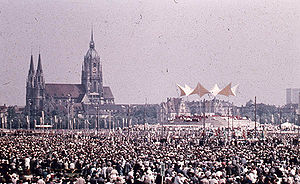
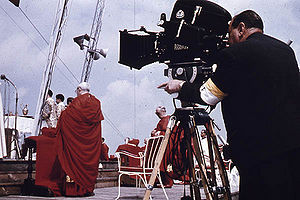
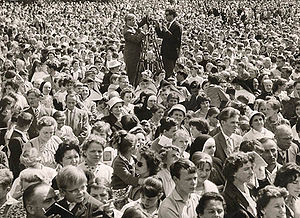
In Munich, the Catholic community of faith presented a holistic version of itself under the motto "Unity in Diversity". Framed by baroque Bavarian festivities, the familiar and well-known mixed with the never before seen and astonishingly exotic in many different ways: "From the Eskimo to the Chinese, from Tierra del Fuego to the descendants of the bounty hunters, all races, many nations were represented. In addition to the red and purple robes of the numerous church dignitaries, the white dresses of dainty Vietnamese women, the colourful saris of Indian women, the traditional costume of the gauchos and the headgear of Arab fellah farmers formed a picture of international understanding and unity in faith." (Quote by: Otto Pirner, report on the 37th International Eucharistic Congress, in: Statio Orbis. 1st volume, 37).
About 80,000 believers gathered on Munich's Odeonsplatz for the opening of the International Eucharistic Congress on 31 July 1960. Cardinal Wendel took up elements of the liturgical movement during the service by facing those gathered for Mass, not standing with his back to the people as usual in the Tridentine Rite, and presented the Gospel in German and not in Latin. The worshipping form of the "prayer and chanting mass", promoted by the liturgical movement since the 1920s, was also important in the many services in the following days. Aside from a large number of agape celebrations, among others at the Hofbräuhaus, and ordinations to the priesthood, the 5th of August was a particularly symbolic day. At the instigation of Auxiliary Bishop Neuhäusler, a former camp inmate, the Todesangst-Christi Chapel on the former Dachau concentration camp grounds was consecrated in the presence of 40,000 believers. This was an important step towards its current form today, not only as a museum memorial, but also as a place of silent prayer.
Besides the many references to a future form of the Church, the congress also provided space to reaffirm historical power and influence. This was most succinctly demonstrated in the "Bavarian Piety - 1400 years of Bavarian Christian history" exhibition presented in the city museum. The concluding service on the Theresienwiese on Sunday, 7 August 1960, was broadcast live by Eurovision to six neighbouring countries and was the final highlight to the festival week. The big altar island with its canopy roof open to all sides was once again shown to advantage, with its design very clearly symbolising the opening up of the Catholic Church and its bridge building towards modernity.
The theological and historical ecclesiastical dimension
In contrast to the previous International Congresses, Munich represents a turning point in that the festive procession with the monstrance, which had been the focus of attention until then, was replaced by stronger concentration on the mass and reception of communion. The universal church was to be deliberately located at a statio, i.e. a location – hence the congress motto "Statio Orbis" and the striking altar island on the Theresienwiese.
The external borders of Catholicism were drawn softer in Munich than they were in the 1950s. Cardinal Wendel reassuringly stated that in the public celebrations of Catholic services one is directed "against no one, neither against a political opponent nor against religiously dissenting people, but prays and sacrifices for everyone, for the life of the world" ("Pastoral homily for the preparation of the International Eucharistic Congress in Munich from 31 July to 7 August 1960," in: Münchener Katholische Kirchenzeitung, No. 44, 1 November 1959). Intensive discussions were therefore held at a large number of external events parallel to the major Catholic events, both with other religious communities and with representatives of the Protestant Church. These did not contain any harsh dogmatic debates on principles, but were intended to show a keen interest in differences as well as in common ground. In Munich, the focus was thus directed towards the city's own diversity and its common foundation on the one hand, but broadened outwards on the other hand. As a result, fruitful groundwork was provided for the subsequent messages of the Second Vatican Council (1962-1965) pertaining to a new position in modernity, a readiness for dialogue and an opening up to the world.
The importance of the International Congress for Bavaria and Munich
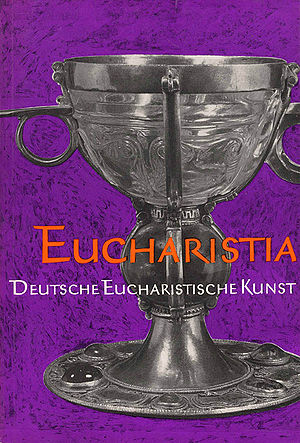
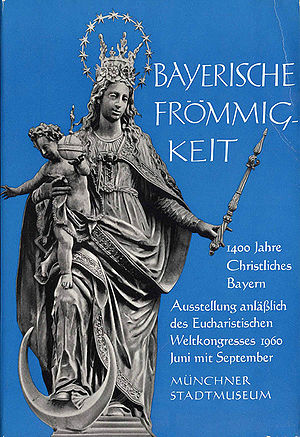
The intensive preparations for the International Eucharistic Congress as well as organisational issues were actively supported by the Bavarian State Government under Hans Ehard (CSU, 1887–1980, Minister President 1946–1954 and 1960-1962) and the Munich local government under Hans-Jochen Vogel (SPD, born 1926, Lord Mayor of Munich 1960-1972)
They were well aware of the huge potential this major event offered to present the city and state in a positive light. Besides economic considerations, such as boosting tourism, the congress also provided an opportunity to accentuate a new reputation for Munich, which had been severely damaged as the " Capital of the Movement" during the National Socialist era. There were attempts to exploit this potential in various ways through brochures, special exhibitions, radio and television broadcasts. It was no less important that the citizens of Munich demonstrated their tolerance and cosmopolitanism during the congress. This was expressed above all in the "Aktion Silbermöwe" ("Herring Gull Campaign"), which motivated Munich's citizens and residents of the neighbouring districts to offer thousands of foreign festival visitors accommodation in their own homes. All in all, important personal and organisational experiences were gained during the festival week – the largest mass event in post-war Germany up to that point with about one million participants – which could be tapped into a few years later when it came to organising the XX Summer Olympic Games in 1972.
References
- Michael Fellner, Katholische Kirche in Bayern 1945-1960. Religion, Gesellschaft und Modernisierung in der Erzdiözese München und Freising (Veröffentlichungen der Kommission für Zeitgeschichte B 111), Paderborn u. a. 2008.
- Roland Götz/Guido Treffler, Gemeinschaft erleben - Eucharistie feiern. Der Eucharistische Weltkongress 1960 in München (Ausstellungen im Archiv des Erzbistums München und Freising 10), München 2010.
- Julia M. Gruber, Präsentation auf internationaler Bühne. Der Eucharistische Weltkongress in München 1960, unveröffentlichte Zulassungsarbeit München 2008.
- Susanne Kornacker, Pro mundi vita - Für das Leben der Welt. Kardinal Joseph Wendel und der 37. Eucharistische Weltkongreß 1960 in München, in: Beiträge zur altbayerischen Kirchengeschichte 45 (2000), 405-431.
- Peter Pfister (Hg.)/Guido Treffler (Red.), Für das Leben der Welt. Der Eucharistische Weltkongress 1960 in München, Regensburg 2010.
Sources
- Richard Egenter (Hg.), Statio orbis. Eucharistischer Weltkongreß 1960 in München, München 1960.
Further Research
External Links
Cite
Michael Fellner, International Eucharistic Congress in Munich, 31 July to 7 August 1960, published 23 April 2013, English version published 21 February 2024; in: Historisches Lexikon Bayerns, URL: <https://www.historisches-lexikon-bayerns.de/Lexikon/EN:International_Eucharistic_Congress_in_Munich,_31_July_to_7_August_1960> (21.12.2025)
